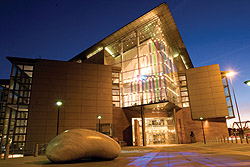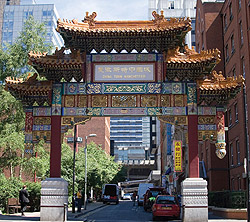About Manchester
“What Art was to the ancient world, Science is to the modern: the distinctive faculty. In the minds of men the useful has succeeded to the beautiful. Instead of the city of the Violet Crown, a Lancashire village has expanded into a mighty region of factories and warehouses. Yet rightly understood, Manchester is as great a human exploit as Athens.”
Benjamin Disraeli, Coningsby; or, the New Generation (1844)
 The Bridgewater Hall, Manchester's state-of-the-art concert venue
The Bridgewater Hall, Manchester's state-of-the-art concert venue Manchester is no longer so straightforwardly the “Metropolis of Manufactures” which burst noisily onto the world stage at the end of the eighteenth century. It is a diverse modern city which has learned complex lessons from the patterns of growth, decay, and regeneration which have shaped it; and its cultural identity appeals, in many ways, to “Art” as much as to “Science.” It remains, however, a city of which the world takes notice.
From a northerly defensive outpost of the Roman Empire to a quiet early-modern market town with a modest reputation for cotton goods, Manchester went largely unremarked until the middle of the eighteenth century. With improving transport links across north-west England, however – and in particular with the opening of the Bridgewater Canal, which secured a supply route of cheap coal to the town – Manchester emerged as the centre of a cotton-focused manufacturing trade requiring an ever-larger workforce. The town grew rapidly, and from the 1790s the distinctive blocky structures of the “cotton mills” – mechanised factories for spinning and weaving – rose to redefine the skyline.
Manchester, however, was never simply Cottonopolis. In supplying the needs of the surrounding textile towns, it developed a reputation in precision engineering, and in areas of chemistry such as bleaching and dyestuffs; and, increasingly, as a centre for research and higher education. Into the twentieth century, it remained a significant site of technological and industrial innovation and international commerce. Following the Second World War, with a decline in manufacturing industry across the industrial heartlands of the UK, the city repositioned itself once again. On the world stage, it is perhaps best known for its contributions to leisure, entertainment and culture: its two world-class football clubs; its musical successes, both cult and mainstream; its new media industry, entertainment venues and heritage attractions.
 The Chinese Arch on Faulkner Street, emblem of the city's Chinatown
The Chinese Arch on Faulkner Street, emblem of the city's Chinatown Those who wish to take a break from the themes of the Congress will find plenty to do in and around Manchester. There is excellent retail shopping in the city centre; two major art galleries; an impressive range of nightlife; a famous medieval library; and, within easy travelling distance, pleasant market towns, historic houses, and the scenic Peak District and Lake District National Parks.
Manchester should, however, hold a particular appeal for scholars of the history of science, technology and medicine. The region is uniquely rich in industrial heritage; and the Congress takes place at The University of Manchester, on the site of some of the key developments of twentieth-century science. Guided visits, display materials and talks will be available to help you make the most of these connections during your time in Manchester.
Our guides to food and drink in Manchester
Drinks guide: pubs, bars, cafés...